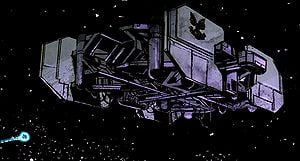Slipstream space probe
From Halopedia, the Halo wiki
Slipstream space probes, also referred to as slipspace science probes,[1] are scanning devices utilized by UNSC Remote Scanning Outposts.
Overview
In repeated cycles, scanning stations deploy three probes, referred to as Alpha, Beta and Gamma, respectively. These probes are designed to survive the transition into Slipstream space; as a result they are almost solid Titanium-A.[2] They journey into slipspace for a short period of time where they send out radio pings and analyze the spectrum from radio to X-ray. The probes then re-enter back into normal space and broadcast the data collected back to their stations. Due to the odd nature of interdimensional space, slipspace probes could at times return to normal space exactly where they had originally left, or re-emerge millions of kilometers away. They may also return at different times, due to the nature of slipspace. In some cases, probes never returned back at all. Scanning stations had to dispatch drones to retrieve the probes before the process could be repeated.[3] The probes are not designed to function in the vicinity of gravity wells.[4]
Archimedes RSO probes
In 2552, the probes of the Archimedes, a remote scanning outpost at the edge of the Sigma Octanus system, detected a Covenant fleet en route to the planet Sigma Octanus IV.[5]
The Station's Alpha probe detected a large mass approaching the system. The Beta probe then reported the same findings as the Alpha Probe and gave the mysterious object a mass of 20,000 tons. When the Gamma probe reappeared, it reported the same findings but its spectroscopic analysis proved to be inconclusive.
William Lovell, who was stationed aboard the Archimedes at the time, noticed the object's trajectory was parabolic and believed it would pass through Sigma Octanus IV. He collected the relevant data and logged the anomaly. Such an anomaly had been previously described by Fhajad-084 in an astrophysics paper published in 2540. This later allowed Commander Jacob Keyes to properly alert the other ships in the system of an impending attack.
Fermion RSO probes
The probes of the RSO Fermion in the Epsilon Eridani system were the first to detect the silhouette of the incoming Fleet of Particular Justice in August 30, 2552.[6]
The Station's Alpha probe detected a large object more than 3,000 kilometers in diameter inbound to the station. CPO McRobb recognized the anomaly and immediately ordered the crew of the Fermion to enact the Cole Protocol. Shortly after, the station's Beta Probe re-appeared into normal space partially damaged. When the station's Gamma Probe did not transmit a signal upon returning to normal space, Lieutenant Brightling suspected that the probe may have translated on a temporal axis. However, Chief McRobb knew the probe had likely been destroyed or jammed by the incoming fleet.[7]
Other uses
In 2547, Doctor Catherine Halsey used a slipspace probe she had procured from Reach's early warning slipspace observatory (likely Fermion) to launch an AI seed into slipspace as part of an experiment to construct a virtually unlimited AI housing fractal. While the AI became functional Halsey lost contact with the probe soon after, leaving its fate unknown.[4]
List of appearances
- Halo: The Fall of Reach (First appearance)
- Halo: First Strike (Mentioned only)
- Halo: Ghosts of Onyx (Mentioned only)
- Halo: Fall of Reach
Sources
- ^ Halo: Ghosts of Onyx, page 105
- ^ Halo: First Strike, page 296 (2003)
- ^ Halo: The Fall of Reach, page 136; 2010, page 160
- ^ a b Dr. Halsey's personal journal, September 4, 2547 (Excised leaves: 1, 2)
- ^ Halo: The Fall of Reach, page 137
- ^ Halo: The Fall of Reach, page 137
- ^ Halo: The Fall of Reach, page 285
